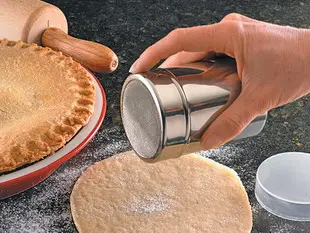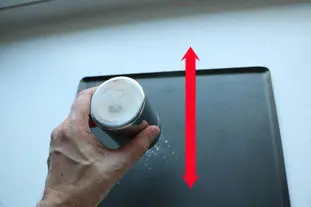The proper use of a dusting machine

Let's take a look at a simple gesture, the sprinkling, that is to say to distribute a fine powder (icing sugar, sugar, flour,...) on a surface.
If you have to sprinkle something, you may use a sprinkler or "poudrette" (in french) it is a very simple utensil, a box, with a lid pierced with holes more or less big, or a sieve, but very practical, with it you can sprinkle regularly what you want.
If you have to sprinkle something, you may use a sprinkler or "poudrette" (in french) it is a very simple utensil, a box, with a lid pierced with holes more or less big, or a sieve, but very practical, with it you can sprinkle regularly what you want.
11 K 4.6/5 (18 reviews)
Keywords for this post:GestureTipTrickPowderSprinkleLast modified on: July 31th 2019
The proper use of a dusting machine
It's not rocket science, is it?
No, indeed, but if you take a shaker (or a salt or pepper shaker etc.) in your hand, you will naturally use it like this, from top to bottom:
How to do it?
The trick, and the good gesture with this kind of utensil, is to handle it "flat", like this:
This way, the powder inside moves in the shaker, doesn't clog the outlet, and is much easier to distribute.
Humidity, the enemy of powdered productsIn
the same spirit, if you use a salt shaker above a dish that is cooking, and inevitably releases some steam, you will inevitably moisten the salt contained inside, and as you go along this moistening will increase until it more or less clogs your salt shaker, and this even if you hold it the right way round, i.e. flat, as you know now ;-).Can you avoid this?
Not really, in fact, even if you do it quickly, your salt will get a little bit wet, and over time...It's inevitable, but it can be corrected : You just have to put your salt shaker in a soft oven (we say "falling"), for a while, to dry again its content. The best way to do this is to put it in the oven after cooking a dish, remove the dish, turn off the oven, and put the salt shaker in. Leave it for a good hour, with the lid off if possible, until all the salt in it has dried completely.
To sum up: 1) To use a salt shaker, hold it "flat". 2) To dry a clogged salt shaker, put it in a low oven (hot, but turned off) for 1 hour.
Lasts posts
Butter vs. grease
We often read in a recipe where a pastry is put into a mould that, just before pouring, the mould should be buttered or greased. But what's the difference between these 2 terms?December 1st 20254915
Getting out of the fridge early
Very often when you're cooking, you need to take food or preparations out of the fridge, to use them in the recipe in progress. There's nothing tricky about this: you just take them out of the fridge and use them, usually immediately, in the recipe. But is this really a good method?November 24th 20258995
Who's making the croissants?
When you look at a bakery from the outside, you naturally think that in the bakery, the bakers make the bread, and in the laboratory, the pastry chefs make the cakes. It's very often like that, with each of these professions having quite different ways of working, but sometimes there's also one...November 23th 2025798
Oven height
When we put a dish or cake in the oven, we naturally tend to put it on the middle shelf, and that's what we usually do. But in some cases, this position and height can be a little tricky, so let's find out why.October 8th 20252,3785
The importance of sieving
In recipes that use a fine powder (flour, powdered sugar, etc.), you'll often see the advice to sift before using it. To sift is to pass the powder in question through a sieve (a very fine strainer) before incorporating it into your recipe. It's often advice, but is it really useful?September 3rd 20257,3053
Other pages you may also like
The window-pane test in bread-making
The home bread-makers often ask themselves “Have I kneaded my dough long enough?” . A good question, as dough that is insufficiently kneaded will not rise properly or will fall flat when the top is slashed, which is very frustrating. To know when the dough is ready, one can rely on the length...June 16th 202196 K 23.9
85 grams of eggs?
Some time ago, I already spoke to you about the difference between baking and pastry-making, I emphasized, among other things, the precision of pastry-making which requires grams, cm, degrees and minutes. That's why, on the one hand, you have baking and cooking, where a certain tolerance is...November 26th 201856 K4.6
Unmoulding cakes while hot
When you make a cake, pound cake or whatever (what bakers call a "travel cake" because it's easy to carry around) you've most likely made a batter, either by hand or in a food processor, which you then pour into a buttered pan. It's a classic, and I've already talked to you about 2 or 3 tips on...February 6th 202138 K4.6
The right size of zucchini
When you buy zucchini at the market, you're often offered a wide variety of sizes, from very small to very large. But which ones to choose? Here are a few tips.September 9th 20249,8485
Butter doesn't make you fat, unless you eat too much of it.
Whenever I'm discussing cooking and recipes, there is one idea which comes up frequently, like this: "Oh no! But that's got butter in it" (I should add, for the sake of accuracy, that this is something I hear more frequently from women, who are almost all concerned with keeping their figure). ...March 26th 201245 K4.5
Post a comment or question
Follow this page
If you are interested in this page, you can "follow" it, by entering your email address here. You will then receive a notification immediately each time the page is modified or a new comment is added. Please note that you will need to confirm this following.
Note: We'll never share your e-mail address with anyone else.
Alternatively: you can subscribe to the mailing list of cooling-ez.com , you will receive a e-mail for each new recipe published on the site.









